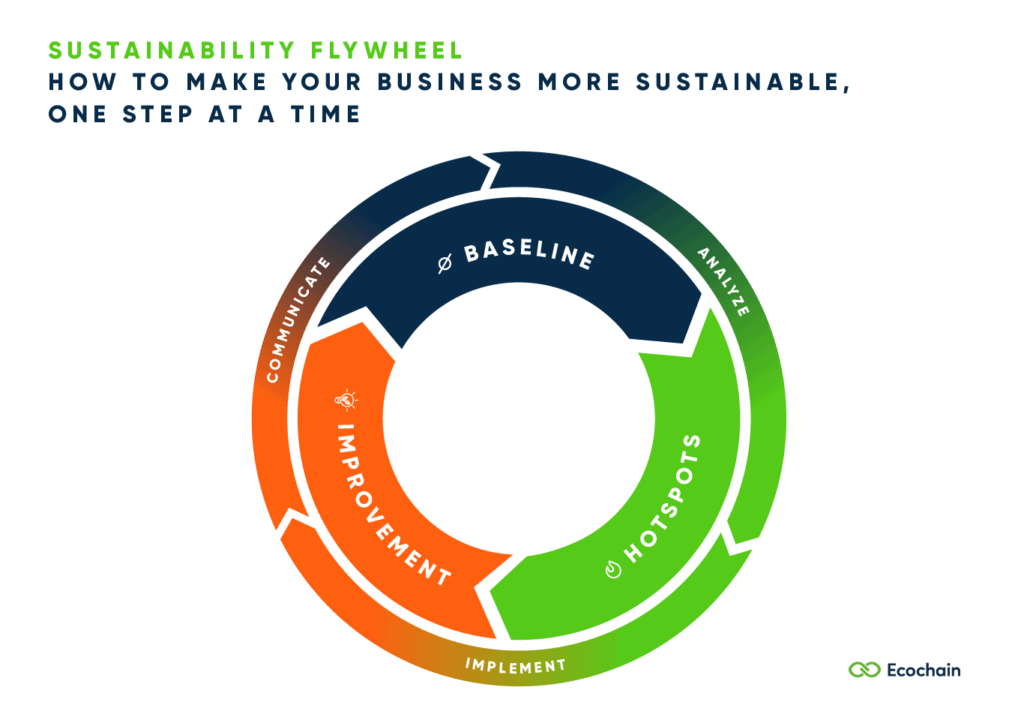There’s no silver bullet for a sustainable business. Becoming a sustainable, or more sustainable, business, is a process.
Becoming more sustainable: The Sustainability Flywheel
We define the process of becoming more sustainable through the Sustainability Flywheel:
In order to improve your performance, you need to analyze your baseline emissions. This will help you understand the hotspots in your environmental performance – and thus help you to improve on it.
But every improvement also brings with it a new baseline – and new hotspots. So far, so simple.

Sustainability Maturity Model: More than just lip service
The Flyhweel is a framework to improve your environmental performance based on data. But many processes require more than just data. Sustainable change can only be driven when the three value pillars of a sustainable business are aligned: Motivation, Accountability, and Ownership. That’s what we’re assessing with the Sustainability Maturity Path, a model originally created by PWC and adopted by us.

Motivation: Why are you acting on your environmental performance?
The motivation behind a business’ environmental decisions is the key to understand its activities. In the beginning, activities are entirely driven through external market forces (regulations, customer demand), while in later stages, the company is internally driven to create sustainable change.
Stage 0: Disregard
A company doesn’t act with the environment in mind. Since most industries have some form of environmental regulation, this would be an exception
Stage 1: Compliance
If a company’s environmental decision making is driven by compliance, it’s solely to reduce operational risk and to comply to regulations.
Stage 2: Obligation
When a company complies to the expectations of outside market forces, it is motivated by Obligation. That can be the case when customers are demanding certain products, proof, or validations. The company is not motivated by internal forces yet, but by outside market forces. However, it is acting more proactively than just to comply with regulations.
Stage 3: Efficiency
Many companies realize that Environmental Process Optimization can actually lead to operational cost savings. That doesn’t mean they’re purpose-driven, but they actively try to reduce harm in order to become more efficient. That is usually the stage in which full-time sustainability personnel takes ownership of the processes (more on ownership later).
Stage 4: Leadership
When a company actively pursues sustainable innovation and views it as brand enhancement, it starts to be driven more from an internal perspective. The leadership team is highly bought into sustainability as a management philosophy, and sustainability becomes a driver for long-term viability of the business. Innovative products or business models are actively pursued.
Stage 5: Purpose
Purpose-driven companies are aiming to create value for society and the environment beyond business economics. They are often founded with that purpose specifically in mind. Sustainability is not a factor to consider, but the main factor in any decision made in the business. That doesn’t mean that the company’s not aiming to be profitable – it simply means that compromises are the exception, not the norm.
Beginners Guide:
Learn to create products – fit to fight climate change. In this guide we share tips from product designers. And the 3 steps to creating environmentally sustainable products – guided by environmental data.

How to design – with the environment in mind.
Qualifying factor: Accountability
When talking to business leaders and owners, most companies will say that they are motivated by purpose or leadership. And are thus in the higher ranks of the Sustainability Maturity Path.
While the motivation itself can be hard to measure, there are some hard qualifying factors that need to be met to reach the next stage in the maturity model.
One of these factors is Accountability. Are there Key Performance Indicators (KPI) for environmental activities in the company?
Stage 1: Compliance
In the compliance phase, no environmental KPIs are defined. Compliance is simply delivered ad-hoc with minimum legal requirements.
Stage 2: Obligation
The only difference between the obligation and the compliance phase is that ad-hoc requests can also be answered for the market. For example, a customer requesting an EPD.
Stage 3: Efficiency
Environmental KPIs are defined on a functional level. Operational decisions are partially influenced by environmental KPI.
Stage 4: Leadership
There are top-level KPIs for the company’s environmental performance. Management is partially measured by environmental KPI. Incentive systems are strongly influenced by environmental KPI.
Step 5: Purpose
Environmental KPIs are defined for decision-making on every level. Environmental considerations outweigh economic considerations.
Qualifying factor: Ownership
Who owns sustainability in your organization? Many companies claim to be purpose-driven or sustainable leaders, but it’s hard to believe if no one is dedicated to the task.
Stage 1: Compliance
Environmental topics are ad-hoc owned by whoever is responsible (legal, operations).
Stage 2: Obligation
Sustainability is owned by QHSE (Quality, Health, Safety, Environment) managers in functional ownership, or by part-time sustainability managers.
Stage 3: Efficiency
Sustainability is owned by full-time, dedicated sustainability personnel.
Stage 4: Leadership
Sustainability is owned by top-level management, with a dedicated executive responsible on the C-Level (Chief Sustainability Officer).
Stage 5: Purpose
Environmental decision-making happens on every level of the company, and everyone is responsible for environmental performance.

How can you empower (even more) sustainable change?
I hope that the Sustainability Maturity Path inspires you to examine your own organizations. Where can you improve your organizational setup in order to create more value for the planet?
